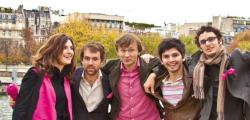Best Places to Ride your Bike in Barcelona
Barcelona is one of those magical cities whose attractions not only amaze you, but also remind you of how capable and diverse we as a people are. To truly experience this exceptional attraction, Barcelona offers its tourists an array of different tours to choose from, including different types of bike tours that are pocket-friendly and well-detailed.
What makes Barcelona great for riding a bike? Its weather is warm and dry most of the time, it is filled with over 300 km of interconnecting bike lanes and the centre of the city is relatively flat thus you do not strain when cycling. If you want to go in-depth o how safe it is to cycle in Barcelona, have a read on how safe is riding a bike in Barcelona.
This beautiful Mediterranean city is filled with some of the best must-see attractions and famous landmarks in the world. It is filled with exceptionally stunning blue beaches, artistic architecture that incorporates both Gothic and modern designs, perfectly manicured city gardens, collections of the most diverse animal species in its zoos and so much more.
To best maximize your experience this article, the best places to ride your bike in Barcelona, will try to focus on bike lane routes that will take you to as many attractions as possible. Make sure you have your bottle of water, and some cash, and your bike is in top-notch shape as we begin our first bike route.
1. Passeig de Gràcia
Passeig de Gràcia is one of the most important and famous shopping and business boulevards in Barcelona. It is located in the central part of Eixample and stretches from Plaça Catalunya to Carrer Gran de Gràcia, hence its name. The avenue was constructed in 1827 in order to connect Barcelona to the town of Gràcia, which was not part of the city until 1897.
In 2020 the Carrer d’Aragó bike lane between Passeig de Gràcia and Carrer d’Tarragona was opened. It provides continuity for the lane in Rambla de Guipúscoa, in the neighborhood of La Pau. The one-way bike lane allows cyclists to cross the whole of L’Eixample and connect with other intersecting bike lanes. Today, it is one of the most used routes in Barcelona’s cycling network.
This bike lane route passed by several of Barcelona’s most celebrated pieces of architecture with buildings designed by modernista/Art Nouveau architects of fame such as Antoni Gaudí, Pere Falqués, Josep Puig i Cadafalch, Lluís Domènech i Montaner, Enric Sagnier, and Josep Vilaseca. A must-see building on this route is the Casa Milà, also known as La Pedrera. This building is a Modernista building built in 1906 and is famous for its unconventional rough appearance.
Your journey will start off at Plaça Catalunya. This is the main square in Barcelona, where two of the largest shopping areas intertwine. As you continue with your journey you will pass by Mercat de la Concepció whose hangaresque structure dates back to the 18th century, the Perfume Museum with a collection of more than 5,000 items, various eateries where you can sample delicious Barcelona cuisines and so much more.
In addition, Paseo de Gracia is also a luxury shopping hub where some of the most iconic and high-end brands in the world such as Chanel, Hugo Boss, Gucci, Rolex, Swarovski, and Louis Vuitton are located.
Practical information
Book with us: Barcelona Electric Bike Photography Tour
2. Passeig de Sant Joan
Passeig de Sant Joan is a wide multi-lane road that starts at the Arc de Triomf and continues westwards through the Eixample district until it reaches Travessera de Gràcia in the lower part of Gràcia. The avenue was named after a former street carrying a similar name, also known as Passeig Nou, built in 1795 around the glacis of the Ciutadella fortress.
In 2015 renovations made on the promenade resulted in it becoming one of the first Green Corridors in Barcelona. The 1.2 km redesign distributed the road space into wide sidewalks, two car lanes, and a segregated bidirectional lane for bicycles. This resulting in Passeig de Sant Joan having one of the busiest bicycle lanes in the city.
A major highlight of this route is at the beginning of your journey, the great Arc de Triomf. The Arc de Triomf is a triumphal arch that was built by architect Josep Vilaseca i Casanovas. Unlike other arches the Arc de Triomf is a non-military structure, instead it was built as the main access gate for the 1888 Barcelona World Fair to welcome visors. Its front frieze contains the stone sculpture Barcelona rep les nacions (Catalan for “Barcelona welcomes the nations”) by Josep Reynés.
In recent years this route has earned a reputation as one of Barcelona’s best foodie hubs with famous brunch stops such as Granja Petitbó which offers mouthwatering burrata cheese, pastries, and coffee, and other cafés and restaurants.
10 Best Bike Tours in Barcelona
Practical information
Book with us: BARCELONA BIKE TOUR
3. Parc de la Ciutadella
As you continue traveling along the Passeig de Sant Joan, you will enter the Parc de la Ciutadella. This is the largest park in Barcelona, sitting on 31 hectares (77 acres). It is one of Barcelona’s greatest treasures because it is home to many of the city’s popular landmarks, attractions and history.
Parc de la Ciutadella is Barcelona’s first National park. The parks’ history dates back to 1888 when the park was first used as the site for the Word Fair, the Exposición Universal de Barcelona. The redesigning of the park signified the end of the old provincial Barcelona and the beginning of a modern, cosmopolitan city. In 1951, it was declared a Historic-Artistic Monument.
Exploring the park by bike is a great option because of its relatively big size, and it is lined with many interlinking paths. With each turn of your bike, you will be amazed with the countless things you can explore since the park is home to the Barcelona Zoo, the Palau del Parlament de Catalunya, a small lake, museums, and a large fountain designed by Josep Fontserè.
For a great family day out, you can incorporate a picnic on the well manicured grass of the park.
Practical information
Book with us: Barcelona Highlights Bike Tour
4. Carretera de Les Aigües
Carretera de Les Aigües translates to water road, is a sooth gravel road surrounding the Collerola Park. Collserola Park is one of the largest metropolitan parks in the world, covering an area of 84.65 km². It is located in a mountain range between the rivers Besòs and Llobregat.
This 9 km cycling path was once used a service road for a pipeline that transported water from a cistern at Sant Pere Màrtir. The Funicular de Vallvidrera is the easiest way to get to the cycling pathway. After which you can start your uphill cycle surrounded by beautiful nature.
Collerola Park is covered with over a thousand major plants and around thirty plant communities have been cataloged; including forests of Aleppo pines and nut pines, evergreen oaklands, riverside copses, maquis and scrublands, brush, and savannah grasslands. As you ride your bike, try to spot the different plants and flowers.
A variety of wildlife can found here including wild boar, genets, stone marten, badger, rabbit, and squirrel; blue tits, whitethroats, treecreepers, woodpeckers, bee eaters, doves, goshawks, sparrowhawks, and rat-catching eagles; salamanders, newts, green tree frogs, the small southern frog, toads, the small spotted toad, the Mediterranean turtle, the giant turtle, the ocellated lizard, snakes, and so on.
In addition to the beautiful fauna and flora, bikers can also enjoy stunning aerial views of the city below. Get to truly see the wonderful beauty of Barcelona from a far.
Top 10 Barcelona Bike Rental Locations.
Practical information
Book with us: Barcelona Bike Tour in Half-Day
5. Route of Montserrat
Montserrat is a holy mountain for Catalan people, located in the north-east of Spain. It’s history dates back to 880 when a small group of shepherd children saw a bright light descending from the sky in the Montserrat mountains. Today the vision sites has been marked by a Holy Grotto which has been ordained a holy place.
When translated, Montserrat literally translates to “saw mountain”. Montserrat Mountain was established as a natural park in 1987. This makes it the first national park in Spain. This mountain is a popular pilgrimage center known to house an important dark wooden sculpture of the Virgin Mary holding the infant Jesus, known as La Moreneta.
The Montserrat route is a 49 km uphill cycling challenge that starts off at Olesa de Montserrat, taking Carretera de la Puda or C-55 to Monistrol. Along the way you will cross the Llobregat river, this is the second-longest river in Catalonia, Spain. This river is critical as its water is used to irrigate the coastal plain around its mouth and has several hydroelectric power stations.
As you continue with your journey you will also pass Castellbell, Marganell and el Vilar before finally reaching the Monastery of Santa Cecília. The Monastery of Santa Cecília is a Benedictine monastery. Get to learn the rich history of this monastery that was founded in 945.
Finally, proceed to the monumental complex of Montserrat and explore the complex with all it has to over.
To conclude, Montserrat Monastery is not only known for its significant religious importance to the people of Barcelona, but the natural beauty surrounding the monastery is simply breathtaking.
Practical information
Book with us: Barcelona Highlights on Electric Bike Tour
Explore more of the city’s breathtaking places by booking our available tours in Barcelona.

 English
English













